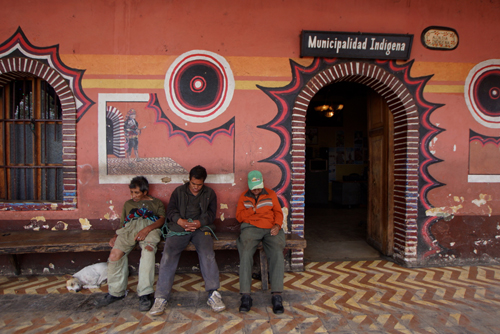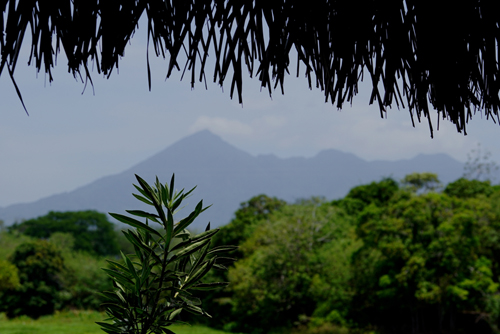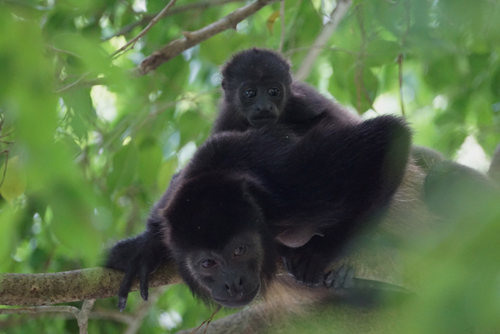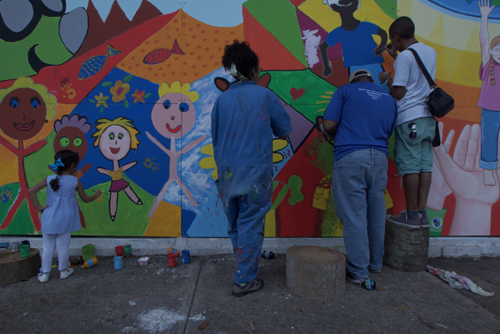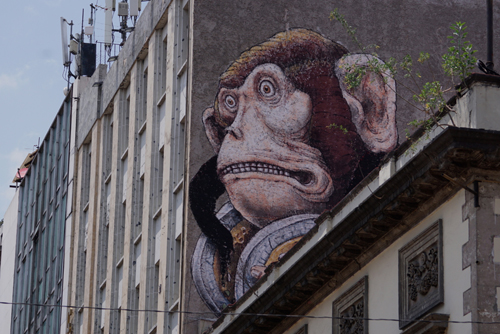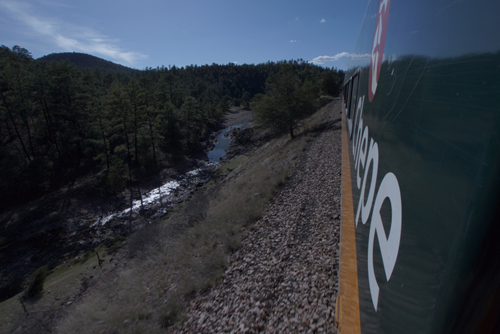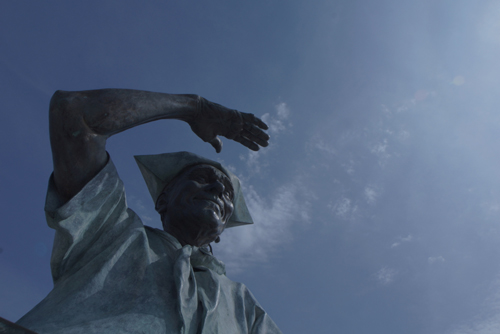It was a long day from Belize to Los Angeles, California.
A 4:30am start, three taxis, a boat and two flights later we were in LA.
We were staying right on the boardwalk in Venice Beach, a good choice considering it was only 20 minutes from LAX.
We hadn’t had much exercise over the last week in San Pedro, so we made up for it with a 23km walk around Venice Beach and Santa Monica.
LA is a city built for the automobile and everything is miles apart.
People talk about just a few minutes to get from place to place – this is by car of course.
Our long walk down to Santa Monica culminated with a short stroll along the famous pier.
Built in 1909 it is one of the main attractions of this seaside town.
There is even a parking lot on the pier – another acknowledgement to the dominance of the auto.
The pier is home to a solar powered Ferris wheel, aquarium and a 1920s’ carousel.
It’s similar to the pier at Brighton, England, but no where near as long and without the charm of the British seaside resort.
Santa Monica had a couple of very big differences. The first is the long sandy beach, which stretches north and south for kilometers.
Then there’s the surf, which again runs the entire length of the beach, and is very consistent.
Pale blue life saving huts are situated every 200 meters or so along the beach, conjuring up images of Bay Watch and the well augmented Pamela Anderson.
‘June Gloom’ is how the weather is described at this time of the year.
The days start out chilly, with heavy cloud cover, but clear to a bright blue sky by the afternoon.
Los Angeles is a big city, so their Hop-On-Hop-Off bus is a great way to see a lot, and learn a lot about its history.
There are five major routes in the StarLine Tour agenda.
We managed to fit in three of them over a twenty four hour period.
The first was the Yellow Route, through Santa Monica and Beverly Hills. We then transferred to the Red Route which took us into the heart of Hollywood, along Melrose Avenue and then down Sunset Street.
The next day we took the Blue Route from Santa Monica to Venice Beach and down to Marina Del Ray.
I sat up on the top deck of the bus, with a permanent grin on my face.
This was the stuff of dreams.
These places are part of our pop culture and many of the locations were immortalised in TV shows from the 50s and 60s.
Seventy Seven Sunset Strip and The Beverley Hillbillies spring to mind.
Apart from movies and TV, Los Angeles has been home to other Twentieth Century phenomena’s. The surf culture and surf music of the 60s, as well as the rise of skateboarding and extreme sports in the 70s, all started in the LA area.
All this nostalgia was heightened by the excellent on-board commentary, done by a voice over with a very English accent.
He seemed to add humor and whimsy to the trip.
Then there’s the actually history of LA.
Venice and Venice Beach was founded, as a seaside resort, in 1906 by the tobacco millionaire Abbot Kinney and originally called Venice America. The canals were designed to drain the area, which was marshland. Unfortunately they weren’t deep enough and soon started to silt up.
There is now only a small number of the canals remaining, but these are where the prime properties are to be found in Venice.
Venice and in particular the Venice boardwalk, which isn’t actually a boardwalk but a long strip of asphalt, is home to to a variety of street people, performers, hawkers and a constant stream of tourists.
It’s like a 4.2km long circus stage.
Large murals are a part of the Venice landscape. There was one on the side wall of our hotel and many others along the Venice boardwalk. In South Venice, just near the canals, there’s even a three story high portrait of Mr Kinney.
On Sunday afternoon we visited the Getty Centre. This is high up on a hill with tremendous views of LA. It was opened in 1997 at a cost of $1.3 billion and you can certainly see where the money has gone. The buildings are all marble with the landscaping complementing the cliff top location. There is even a hovertrain to transport the visitor to the museum complex.
We decided to try the LA public transport system. Probably not one of our smartest moves as this is a city designed for driving.
An hour and a half later we reached our the Getty Centre, with really only enough time to explore the gardens. There was excellent sculptures, one by Henry Moore and another by René Magritte.
Just down the boardwalk from our hotel was the Venice Ale House, with 30 draught beers on offer.
Here we met a tree. This guy was on stilts, dressed as a tree and came into the Venice Ale House for a coconut juice.
As he told us he “…works the Santa Monica beaches.”
What else does a tree do.
As we have seen from Paris to Panama the craft beer scene is everywhere. There were at least four other such pubs in the Venice and Santa Monica area.
IPA or India Pale Ale seems to be one of the styles most prevalent. Everywhere we have been I have found at least three or four on offer.
Having got a real taste for LA and the surrounding areas, on the Hop-On Hop-off bus, we felt it needed a more in-depth investigation.
So we hired a car. This time a VW Jetta, which was a class above what we had been driving in Central America.
Our first stop was Malibu and Zuma Beach, which is north of LA.
Ever since we arrived there has always been the June Gloom, with dark foreboding clouds hanging over us every morning.
Now there was a fog.
The summer holidays have started so there were families, university students and large groups of teenagers on camp holidays.
They looked a little out of place on this Malibu beach surrounded by fog.
From there we went in search of houses, not just any houses but those that were designed by the American icon and architect, Frank Lloyd Wright (1867-19590). The two we did find, that were unfortunately closed, were Ennis House and Hollyhock House. These are built in, what has been termed, a ‘Mayan Revival’ style.
Frank Lloyd Wright was not only an architect but an interior designer and a leader of the Prairie School. He designed everything from skyscrapers to schools but he is best known for his private houses. Many of these were built for the wealthy new rich who were the patrons of the Arts and Crafts movement that had been developed in the United Kingdom.
Wright was a complete designer in that he considered all elements of the building. He designed the tiles, windows, wallpaper and even the furniture.
His driving philosophy was nature and many of his works express this. Hollyhock house was built using prefabricated concrete blocks with styalised hollyhock motifs decorating the structure.
Many similarities can be drawn between Wright’s approach and that of the famous Catalan architect Antonio Gaudi.
With both architects, nature was their inspiration.
We then drove up to Mount Hollywood to visit the Griffith Observatory again it was closed. Opened in 1935, it has been the set for dozens of Hollywood’s movies. ‘Rebel Without a Cause’ is one of the most famous.
Los Angeles is more like a large Hollywood set than a city.
At the base of Mount Hollywood is the Greek Theatre. Again this location conjured up memories of Neil Diamond’s Hot August Night, that was recorded there in 1972.
From the observatory we had a great view of the Hollywood sign, which has become an cultural icon of the city. It was originally erected in 1923 to advertise real estate and read ‘Hollywoodland’.
Late in the afternoon we drove around the streets of Beverly Hills or ‘90210’ This was developed in 1914 by a group of investors who were looking for oil but only found water.
The next day, after dropping off the car, we again attempted to tame the LA public transport system.
I can see why most people drive.
It takes forever to get anywhere and the buses we travelled on seem to be frequented by LA’s more colourful characters.
No wonder we got strange looks from anyone we told we were using ‘The Metro’.
Our primary destination was the Los Angeles County Museum of Art or LACMA on Wilshire Boulevard. Established at its current location in 1965 it holds more than 120,000 works covering the history of art.
We concentrated on two of the temporary exhibitions.
The first was by Noah Purifoy (1917-2004) titled ‘Junk Data’ Noah was a black American Assemblage Sculptor of found objects. He was very active in using his art to draw attention to the problems of homelessness amongst black communities.
In complete contrast we then visited an exhibition by Larry Sultan (1946-2009) a white middle class urban photographer. His photography was all about ambiguity and featured many locations in the LA suburbs.
Later in his career he collaborated with Mike Mandel, to develop work that poked fun at LA advertising, especially billboards, of the 70s and 80s.
These posters look like real ads but said nothing.
A lot like much of today’s advertising.
It was then back on the bus for the long ride back to Santa Monica and Venice Beach.


